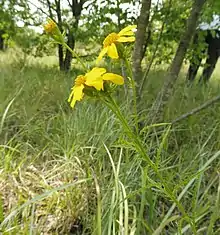| Dysodiopsis | |
|---|---|
 | |
| Scientific classification | |
| Kingdom: | Plantae |
| Clade: | Tracheophytes |
| Clade: | Angiosperms |
| Clade: | Eudicots |
| Clade: | Asterids |
| Order: | Asterales |
| Family: | Asteraceae |
| Subfamily: | Asteroideae |
| Tribe: | Tageteae |
| Subtribe: | Pectidinae |
| Genus: | Dysodiopsis (A.Gray) Rydb. 1915 |
| Species: | D. tagetoides |
| Binomial name | |
| Dysodiopsis tagetoides (Torr. & A.Gray) Rydb. | |
| Synonyms[1][2] | |
|
Synonymy
| |
Dysodiopsis tagetoides, commonly known as false dogfennel,[3] is a species of flowering plant in the family Asteraceae.[1] It is native to the United States, where it is restricted to Oklahoma and Texas.[4] It is found in areas of calcareous soil.[5]
Dysodiopsis is a monotypic genus, and therefore contains no other species.
Description
Dysodiopsis tagetoides is a perennial herb up to 80 cm (6 feet) tall. The plant produces flower heads one at a time or in loose arrays, each head containing as many as 12 yellow ray florets and up to 40 dull yellow disc florets.[6]
References
- 1 2 Tropicos, Dysodiopsis (A. Gray) Rydb.
- ↑ Flann, C (ed) 2009+ Global Compositae Checklist, Dysodiopsis A.Gray
- ↑ USDA, NRCS (n.d.). "Dysodiopsis tagetoides". The PLANTS Database (plants.usda.gov). Greensboro, North Carolina: National Plant Data Team. Retrieved 26 February 2017.
- ↑ "Dysodiopsis tagetoides". County-level distribution map from the North American Plant Atlas (NAPA). Biota of North America Program (BONAP). 2014. Retrieved 26 February 2018.
- ↑ Diggs, George; Lipscomb, Barney; O'Kennon, Robert (1999). Flora of North Central Texas. Botanical Research Institute of Texas. p. 346.
- ↑ Dysodiopsis Flora of North America
This article is issued from Wikipedia. The text is licensed under Creative Commons - Attribution - Sharealike. Additional terms may apply for the media files.